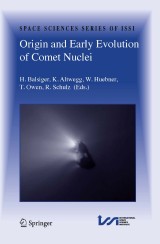Details

Origin and Early Evolution of Comet Nuclei
Workshop honouring Johannes Geiss on the occasion of his 80th birthdaySpace Sciences Series of ISSI, Band 28
|
149,79 € |
|
| Verlag: | Springer |
| Format: | |
| Veröffentl.: | 27.09.2008 |
| ISBN/EAN: | 9780387854557 |
| Sprache: | englisch |
| Anzahl Seiten: | 320 |
Dieses eBook enthält ein Wasserzeichen.
Beschreibungen
<P>Comet nuclei are the most primitive bodies in the solar system. They have been created far away from the early Sun and it is supposed that their material has been altered the least since their formation. The workshop was bringing together representatives of several scientific communities in the fields of interstellar clouds, star-forming regions, the solar nebula, and comets. The intent was to formulate the current understanding and interconnectivity of the various source regions of comet nuclei and their associated compositions and orbital characteristics.</P>
<P>The goal was to better understand the survival of cometary materials (grains, molecules, free radicals, and atoms) from extrasolar sources (circumstellar shells and molecular clouds), their modifications in the solar nebula, and the effects of their properties on the formation and early physical and thermal evolution of the macroscopic bodies, the comet nuclei, in the various subnebulae. Closely associated is their transport into the outer solar system, the Kuiper belt and Oort cloud. The distinction between direct measurements, in situ or by remote sensing, of cometary material properties and properties derived from indirect means, deduced from laboratory studies and theoretical deductions, was emphasized with the aim to guide future investigations. The book is intended to serve as guide for researchers and graduate students working in the field of planetology and solar system exploration. It should also help to influence the planning of scientific strategies for the encounter of the Rosetta spacecraft with Comet Churyumov-Gerasimenko.</P>
<P>The goal was to better understand the survival of cometary materials (grains, molecules, free radicals, and atoms) from extrasolar sources (circumstellar shells and molecular clouds), their modifications in the solar nebula, and the effects of their properties on the formation and early physical and thermal evolution of the macroscopic bodies, the comet nuclei, in the various subnebulae. Closely associated is their transport into the outer solar system, the Kuiper belt and Oort cloud. The distinction between direct measurements, in situ or by remote sensing, of cometary material properties and properties derived from indirect means, deduced from laboratory studies and theoretical deductions, was emphasized with the aim to guide future investigations. The book is intended to serve as guide for researchers and graduate students working in the field of planetology and solar system exploration. It should also help to influence the planning of scientific strategies for the encounter of the Rosetta spacecraft with Comet Churyumov-Gerasimenko.</P>
Foreword.- Origins of Cometary Materials.- Origin of Comet Nuclei and Dynamics.- Reservoir for Comet Material: Circumstellar Grains.- Interstellar Reservoirs of Cometary Matter.- Cometary Refractory Grains: Interstellar and Nebular Sources.- Dynamical Origin of Comets and Their Reservoirs.- Reservoirs for Comets: Compositional Differences Based on Infrared Observations.- Thermal and Chemical Evolution of Comet Nuclei and Kuiper Belt Objects.- Loss of the Surface Layers of Comet Nuclei.- Distributed Sources in Comets.- How Well Do Experimental Results on Large Samples of Gas-Laden Amorphous Ice Duplicate Deep Impact’s Findings?.- Comet Knudsen Layers.- Morphology–Composition–Isotopes: Recent Results from Observations.- Deep Impact and the Origin and Evolution of Cometary Nuclei.- Assessing the elemental composition of comet 81P/Wild 2 by analyzing dust collected by Stardust.- Composition Measurements of a Comet from the Rosetta Orbiter Spacecraft.- Capabilities of Philae, the Rosetta Lander.- Rapporteur Paper on the Composition of Comets.- The Contributions of Comets to Planets, Atmospheres, and Life: Insights from Cassini-Huygens, Galileo, Giotto, and Inner Planet Missions.
<P>Comet nuclei are the most primitive bodies in the solar system. They have been created far away from the early Sun and it is supposed that their material has been altered the least since their formation.</P>
<P>This volume presents the results of a scientific workshop on comet nuclei and is written by experts working on interstellar clouds, star-forming regions, the solar nebula, and comets. The articles formulate the current understanding and interconnectivity of the various source regions of comet nuclei and their associated compositions and orbital characteristics. This includes a discussion on the transport of materials into the Kuiper belt and Oort cloud regions of the solar system. The distinction between direct measurements of cometary material properties and properties derived from indirect means are emphasized with the aim to guide future investigations.</P>
<P>This book serves as a guide for researchers and graduate students working in the field of planetology and solar system exploration. It should also help to influence the planning of scientific strategies for the encounter of the Rosetta spacecraft with Comet Churyumov-Gerasimenko.</P>
<P>This volume presents the results of a scientific workshop on comet nuclei and is written by experts working on interstellar clouds, star-forming regions, the solar nebula, and comets. The articles formulate the current understanding and interconnectivity of the various source regions of comet nuclei and their associated compositions and orbital characteristics. This includes a discussion on the transport of materials into the Kuiper belt and Oort cloud regions of the solar system. The distinction between direct measurements of cometary material properties and properties derived from indirect means are emphasized with the aim to guide future investigations.</P>
<P>This book serves as a guide for researchers and graduate students working in the field of planetology and solar system exploration. It should also help to influence the planning of scientific strategies for the encounter of the Rosetta spacecraft with Comet Churyumov-Gerasimenko.</P>
The book gives guidance for future investigations in space (Rosetta mission), in the laboratory and in theoretical studies New data from recent comet missions and remote sensing, as well as progress in modeling and theory have advanced the field The origin and evolution of comet nuclei is key to understanding the origin of the solar system

















